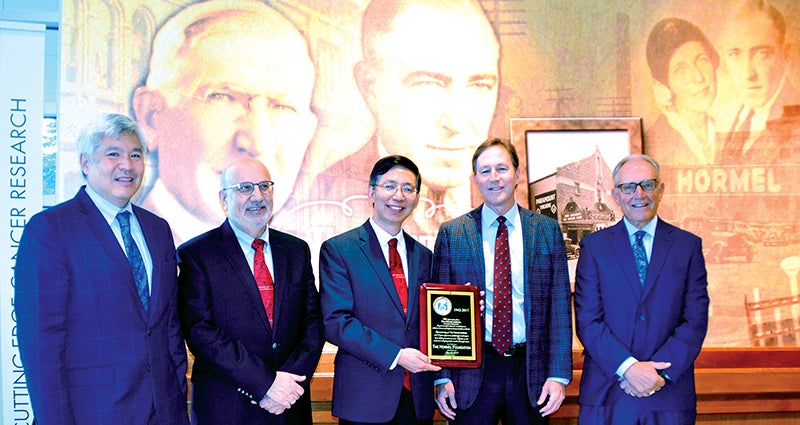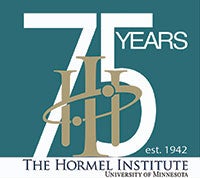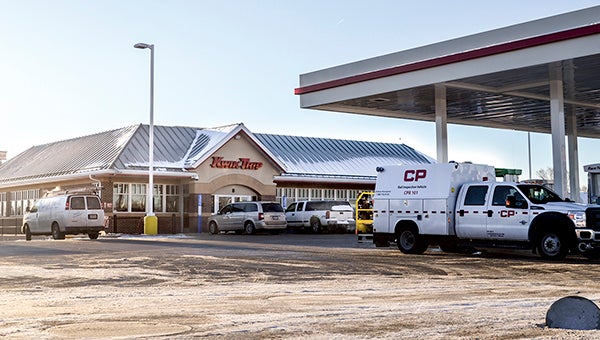Institute celebrates 75 years
Published 8:40 am Wednesday, June 21, 2017

- Leaders gathered at The Hormel Institute, University of Minnesota Monday to celebrate its 75th anniversary. Pictured, from left, are: Dr. Doug Yee, director of Masonic Cancer Center (University of Minnesota); Vice President of Research Dr. Al Levine (University of Minnesota), Dr. Zigang Dong, executive director of The Hormel Institute, UMN; Jeffrey Ettinger, former president, CEO and chairman of the board of Hormel Foods Corp and director of The Hormel Foundation and The Hormel Institute Advisory Board; and Gary Ray, chair of The Hormel Foundation. Photo provided

The Hormel Institute celebrates 75 Years
The Hormel Institute celebrated its 75th anniversary on Monday.
The celebration came during the fifth Hormel Institute International Cancer Research Conference, which was held in the Ray Live Learning Center with 150 invited guests, including representatives from University of Minnesota, Mayo Clinic, state of Minnesota and community supporters.
“The Hormel Foundation is proud of the support we have been part of the last 75 years,” said Hormel Foundation Chairman Gary Ray. “The Hormel Institute is recognized as one of the leading research facilities in the world. Jay Hormel’s insight is still going forward after 75 years.”
Jay C. Hormel founded The Hormel Institute in 1942, and research began in converted horse stables on the Hormel family estate. In 1960, the Institute moved to its current location in a one-story brick building containing 10 laboratories. It tripled in size in 2008, adding 20 state-of-the-art labs and renovating the 1960 building with a major transformation and new lobby.
One year ago The Hormel Institute doubled in size again with the addition of the Ray Live Learning Center and another 20 labs.
Hormel Institute Through the Years
1941: The Hormel Foundation is founded by Jay C. Hormel, the second CEO of Hormel Foods Corp. and the son of its founder, George A. Hormel.
1942: The Hormel Institute is founded on Nov. 20 by Jay C. Hormel, with a mission to conduct research in biological sciences with applications in medicine and agriculture. For many years, The Hormel Institute is the sole recipient of the foundation’s funds, outside of the Hormel family. The Foundation enters an agreement with the University of Minnesota to operate a 400-square foot biological research lab in the horse stables of the Hormel family’s estate outside of Austin. The estate is now Gerard Academy.
1943: H.O. Halvorson, Ph.D., becomes The Institute’s first executive director. Halvorson serves as an advisor to Jay Hormel on food stability.
1949: Walter O. Lundberg, Ph.D., becomes its second executive director, serving for more than 25 years.
1960: The Hormel Institute moves in June from its original location in the horse stable, now at 12,000-square feet not counting animal barns, to its current location at 801 16th Ave. NE, next to Hormel Foods’ corporate headquarters. Its new home has 10 labs to start.
1960s: The Institute supplies “Arnold” the pig for the TV show “Green Acres.” The show airs from 1965 to 1971.
1963: Dr. Ralph T. Holman first names Omega-3 fatty acids in a scientific journal. He also names Omega-6 fatty acids. His work involves collaboration with people from 15 different countries.
1975: Holman becomes The Institute’s third executive director.
1981: Holman is named to the National Academy of Sciences in Nutrition.
1985: Harald H.O. Schmid, Ph.D., becomes its fourth executive director.
2001: The Institute names Dr. Zigang Dong its fifth executive director.
2004-2009: The research of Dong and Dr. Ann Bode, associate director — which makes the world’s No. 1 cancer research journal “Nature Reviews Cancer” — is the most cited in the world in molecular biology for five years.
2006: A busy year for The Institute, as it signs an agreement for collaboration with Mayo Clinic in Rochester, and breaks ground on a $23.4-million expansion. While the agreement with Mayo is the start of the entities official partnership, a Mayo representative has been on the Institute’s board of directors since the lab’s inception.
2008: The Institute finishes its expansion, which triples its size and takes it from 60 to 120 employees. The expansion, which opens on Oct. 3, creates 20 new state-of-the-art cancer research labs.
• The Institute partners with IBM, bringing a BlueGene/L Supercomputer to its lab. At the time, it’s the world’s fastest supercomputer.
•The International Carcinogenesis Symposium is held in Austin, attracting cancer researchers from around the world.
•Dong is selected as a National Institutes of Health Merit award recipient.
2011: The Institute officially announces in October its plans for a $27-million, 74,000-foot expansion, which it says will add 120 jobs.
2014: The Institute plans to break ground on its latest expansion.
2016: Institute finishes and opens its 20-lab expansion that nearly doubled the size of The Institute. It also opens The Ray Live Learning Center and debuts a powerful and flexible high-resolution electron microscope that captures two dimensional (2D) and 3D images using cryo-electron microscopy.
2017: Institute celebrates 75 years.





